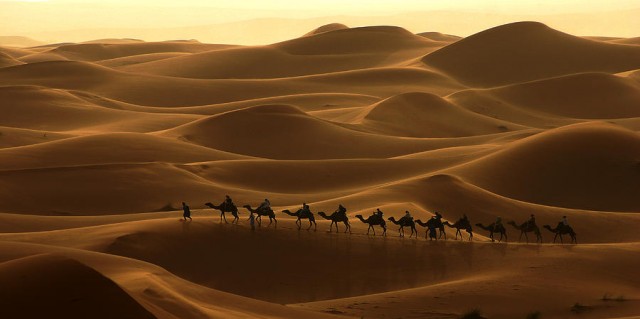erg
THE TERM erg is the Bedouin name for a very large body of sand dominated by sand dunes. Bedouins are an African tribe of nomadic herders living in the northern SAHARA DESERT. Two equivalent English-language terms are sand sea and dune field. Transverse dunes typically are part of ergs, or sand seas. As sand is seemingly everywhere, the dunes appear as waves in a sea of sand. Hollywood made this sandy landscape famous in classic movies such as Lawrence of Arabia, in which sword-wielding Arab horsemen galloped across seemingly endless seas of velvet-soft dunes. Contrary to popular belief, ergs are usually not continuous deposits of fully formed dunes; small inter-dune exposures of underlying bedrock, soil cover, or deposits of ephemeral lakes and streams are common.

Ergs require huge supplies of sand. The sand of an erg is usually from nearby dry lakebeds, ALLUVIAL FANS, smaller dune fields, remnants of earlier sand seas, or coastal dunes. The Namib erg, which stretches along the southern coast of Africa, receives its sand from nearby coastal dunes. Some ergs are surprisingly far from their sand supplies. This fact is especially true in the Sahara Desert of northern Africa, where sand may flow thousands of kilometers before entering a sand sea. Wind patterns will also affect sand supply. For instance, dunes in southern Africa and AUSTRALIA tend to be linear and form whorls (or wheelrounds) that stretch outward from their central areas. These whorls indicate an counterclockwise movement of sand in response to continental anticyclones that dominate the two regions. Topography also affects sand supply. For instance, several ALGERIA sand seas occur close to upland areas, where the uplands extend across the regional trend of sand drift. Some of the more striking sand seas occupy topographic basins. The Simpson in Australia and the Taklimakan in CHINA are examples.
Ergs or sand seas are impressive for their areal coverage. There are major ergs in northern Africa, southern Africa, the Arabian Peninsula, Central Asia, PAKISTAN, and China. The largest contiguous erg covers 1 million square mi (2.5 million square km) in southern Africa's KALAHARI DESERT. Natural vegetation has stabilized most of this sand sea. The largest active sand sea is RUB AL KHALI in SAUDI ARABIA, which stretches across 220,000 square mi (560,000 square km). The region with the greatest number of ergs is northern Africa's Sahara Desert; it has 27.
The proportion of the world's deserts covered in sand varies greatly. AUSTRALIA's large desert is the sandiest, more than 50 percent of it under sand. North American deserts' 2-percent coverage makes that continent's deserts the least sandy. North America has no ergs as a result. The continent's largest dune fields—the Algodones in CALIFORNIA, White Sands in NEW MEXICO, and Great Sand Dunes in COLORADO—are too small to qualify as ergs.